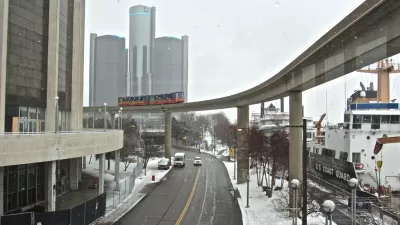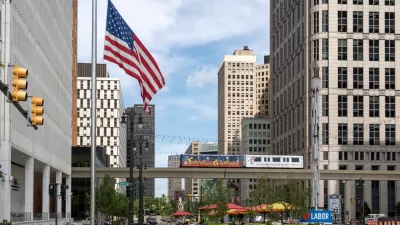Involving four counties and $4.6 billion, the measure proposes a system that could put a million residents (and a million jobs) within a quarter mile of transit.

For a long time, regional transit has been just one more underdeveloped service in southern Michigan. But in November, that will likely change. Angie Schmitt writes, "It took 40 years and 23 failed attempts for Detroit and its suburbs to establish a regional transit agency. They finally won state support to establish the RTA in 2012."
But the Regional Transit Authority of Southeast Michigan can only do so much with its current resources. "Transit service in the region is fragmented and unreliable, even though a quarter of city residents don't own cars. The severity of the problem was encapsulated by the story of James Robertson, whose commute to a factory job in the suburbs required taking two buses and walking 21 miles."
Leading up to the vote this November, "The Detroit region has put together a $4.6 billion, four-county plan to improve transit. The centerpiece is a network of bus rapid transit lines extending out from downtown. Funded by a 20-year property tax increase, the measure would cost the average homeowner in the region about $95 a year."
The plan: four bus rapid transit (BRT) lines connecting Detroit to regional employment centers outside the city proper (as far as Pontiac and Ann Arbor). On top of that, "regional rail" between Ann Arbor and Detroit's downtown.
All signs point to broad regional support for the measure. "Some opposition emerged from the northern suburbs, but key political actors who could have blocked it, like Oakland County Executive Brooks Patterson (the 'Sprawl King') have opted not to."
FULL STORY: Transit Vote 2016: With Historic Decision, Detroit Could Heal Old Divides

Alabama: Trump Terminates Settlements for Black Communities Harmed By Raw Sewage
Trump deemed the landmark civil rights agreement “illegal DEI and environmental justice policy.”

Study: Maui’s Plan to Convert Vacation Rentals to Long-Term Housing Could Cause Nearly $1 Billion Economic Loss
The plan would reduce visitor accommodation by 25% resulting in 1,900 jobs lost.

Planetizen Federal Action Tracker
A weekly monitor of how Trump’s orders and actions are impacting planners and planning in America.

Wind Energy on the Rise Despite Federal Policy Reversal
The Trump administration is revoking federal support for renewable energy, but demand for new projects continues unabated.

Passengers Flock to Caltrain After Electrification
The new electric trains are running faster and more reliably, leading to strong ridership growth on the Bay Area rail system.

Texas Churches Rally Behind ‘Yes in God’s Back Yard’ Legislation
Religious leaders want the state to reduce zoning regulations to streamline leasing church-owned land to housing developers.
Urban Design for Planners 1: Software Tools
This six-course series explores essential urban design concepts using open source software and equips planners with the tools they need to participate fully in the urban design process.
Planning for Universal Design
Learn the tools for implementing Universal Design in planning regulations.
Caltrans
Smith Gee Studio
Institute for Housing and Urban Development Studies (IHS)
City of Grandview
Harvard GSD Executive Education
Toledo-Lucas County Plan Commissions
Salt Lake City
NYU Wagner Graduate School of Public Service





























